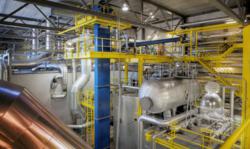Energy from waste (efw) facilities must utilise their heat potential to maximise efficiency and carbon dioxide emissions savings, according to Nick Dawber, Managing Director of UK-based clean energy recovery from waste business Energos.

Speaking at The Waste to Energy City Summit, in London on 21 June 2012, Nick Dawber, Managing Director of Energos told the audience that efw plants should exist within the heart of industrial and residential communities. As such, they can utilise the heat value of the waste instead of wasting this renewable, low cost energy resource.
He said: "To achieve higher levels of efficiency we need to sell heat - either directly as steam to industrial customers to displace existing fossil fuel supplies - or as combined heat and power (CHP). When the ratio of energy used is two parts heat to one part electricity, facilities will achieve up to 50% efficiency, which rises to as much as 85 % if you utilise the full heat potential."
Nick Dawber explained that it is necessary to develop smaller waste to energy plants to capitalise on heat potential since there are more available sites for small facilities, which can be located close to the potential demand for heat and are appropriately sized to satisfy that heat requirement.
He also said that there will be higher public acceptance for 'community sized' advanced conversion energy from waste facilities. Smaller plants minimise traffic to the site and can sit alongside recycling facilities to provide a local solution for local non-recyclable waste while delivering a renewable supply of low carbon, low cost energy.
He stated that a large 400,000 tonnes per annum efw plant, producing around 32MW of electricity, would have a surplus of around 70MW of heat that is normally lost to the atmosphere because there are very few industrial facilities that have sufficient CHP demands for large-scale energy from waste.
Dawber stated: "Small-scale facilities such as Energos’ gasification facilities in Norway and its UK sites, scheduled to open in 2014, can supply usable amounts of energy (up to 20MW of heat) to local customers. Apart from the efficiency benefits, such plants also qualify as a 'recovery' plant under the EU Waste Framework Directive and stand to benefit from the UK's Renewable Heat Obligation.
He continued: "Another approach is to provide a new commercial or residential development with an efw plant to meet its carbon neutral requirements and satisfy planning conditions. Energos is partnering with UK developers to integrate local waste treatment infrastructure with low carbon energy supply for such developments."
Since 2002, Energos' Forus advanced thermal processing facility in Stavanger, Norway, has operated at high efficiency to provide electricity into the local grid and hot water into a district heating system for an adjacent industrial and commercial estate. The 40,000 tonnes per annum EfW plant exists at the heart of the community, handling municipal and commercial waste and complementing local recycling facilities.
The Energos patented gasification technology, an advanced thermal conversion technique, was developed in Norway during the early 1990s in conjunction with the University of Trondheim.
Energos offers a proven and commercially viable gasification technology capable of generating renewable energy from household waste and post-recycling residue. It offers a clean energy recovery from waste solution that provides a best practice alternative to mass-burn incineration and a commercially proven and bankable alternative to landfill.
The company has more than 500,000 hours of operating hours over more than 15 years at eight plants across Europe.
The Energos process converts residual, non-recyclable waste into a gas by using the heat of partial combustion to free hydrogen and carbon in the waste. Residual waste is fed into the gasification chamber, where it is converted into a syngas. This syngas is then transferred to a secondary oxidation chamber where it is mixed with air and recycled flue gas under tightly controlled conditions that ensures complete and efficient combustion resulting in reduced emissions in the flue gases. The upshot is ultra-low emissions that outperform EU Emissions Standard (2000/76/EC), with the resulting heat recovered to produce steam and/or electricity.
A typical 80,000 tonne p.a. Energos plant can serve a community of between 200,000 to 300,000 where recycling levels are around 50%. It has the flexibility to accept a variety of wastes so can adapt to meet the changes in the waste streams over the longer term.
Energos’ newest gasification facility is at Borregaard Industries, Sarpsborg, in Norway. The 78,000 tonne,The 32MWth double-line advanced thermal conversion facility treats non-recyclable commercial and industrial waste and produces 256 GWh/a of high grade steam to displace approximately 22,000 tonnes of heavy fuel oil per annum.
Further information: http://www.energos.com
This press release is presented for your information only.
Full Disclosure Statement: The GREEN (LIVING) REVIEW received no compensation for any component of this article.
This article is for your information only and the GREEN (LIVING) REVIEW does not (necessarily) approve, endorse or recommend the product, service or company mentioned.























